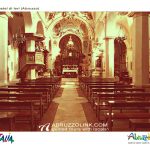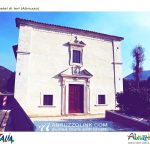The extraordinary story of Minuccia fairy
On May 1987, in a countryside location just outside Castel di Ieri, along the Provincial Road n.9, in the direction of Goriano Sicoli, excavations were under way for the construction of a shed for agricultural use. What seemed like an ordinary day turned, for the village and the neighboring centers, in an unforgettable and exciting moment: while the excavators were doing their job, suddenly emerged ancient remains and molded slabs.
There was no time to lose: the offices of the Superintendence for the Archaeological Heritage were immediately contacted and the first surveys of the area soon took place. The one found by chance that May of thirty-one years ago, was a real treasure, which had to be brought back to light.
Since then, before the temple could be visited, almost twenty years have passed between research, excavations, hypotheses, slowdowns, publications, attributions, discoveries and denials. Scholars now seem to agree on the thesis that sees the sanctuary dedicated to a female deity, linked to fertility, probably Angizia, a peligna goddess whose figure is associated with the cult of snakes.
Yet, even if the excavators had never come across those slabs and if it was decided to build the shed somewhere else, the place around the Piedi Franci area had never lost its sacredness, despite for centuries, earth, bushes and trees, had covered its most hidden treasures.
The road that connects Castel di Ieri to Goriano Sicoli is scattered on both sides of agricultural fields and vineyards, where generations of farmers for centuries have arched their backs and bent down to sow and harvest. Even before Castel di Ieri, like many other southern Italian countries, almost completely emptied, especially after the Second World War, the countryside was crowded with people: a continuous coming and going of voices, songs and words wound along the fields and the streets around.
On those roads there was a great deal of daily life, people worked, sang, suffered, and prayed; there are no tangible remnants of these passages, the upheavals of modernity have swept away millennia of peasant culture, yet the word handed down has been able to withstand time.
For thousands of years the inhabitants of the place, were used, passing by the parts of the temple not yet resurfaced, to bow, a sign of greeting and respect (they took the sign of the cross when the Christian cult took over from paganism); this is what the Casteldieresi elders still tell us, especially the women, who at lunch time went to the fields to deliver the meal to their husbands and family.
In the memories of the legends handed down appears, just where now stands the temple structure, finally returned to its visitors, the enigmatic figure of the “Fata Minuccia”, the magical entity that stood there and that passersby used to greet, as well as the “Queen carried on the shoulder”.
It is a female figure, which does not allude to snakes certainly, but which retains its magical and propitiatory potential in the orality. It is a legend and there is nothing tangible materially, it is only a voice, someone would say, yet it still exists today, it is resisted by time, it is an ancient, almost eternal word of mouth, which has no precise origin, at least until there is only one inhabitant to put together the threads of the incessant story.
On the traces of the divine and its many manifestations, the road that runs along the well-known archaeological area of Castel di Ieri, bears the evident signs left by those who lived there for centuries to come.
Once again, even after many years, the locals built their religious buildings along the same route: I speak of the two rock churches of the Madonna del Soccorso and that of Pietrabona, small sanctuaries linked to the Catholic Christian cult and dedicated both to the Madonna, probably built next to or in place of ancient pagan places of worship, already scattered from before along the same trajectory.
While the Madonna del Soccorso is a rural church dating from the seventeenth century and, like many other churches in Italy, especially in the south, is entitled with one of the most frequent appellations through which the Catholicism venerates the mother of Jesus, the Madonna di Pietrabona clearly preserves in its very name it is a much more ancient legacy: the religious building is presumably in the same place where centuries before another, which belonged to the pagan sphere and, in particular, to the Dea Bona, a deity also venerated among the Peligni family.
The church of Pietrabona is attested by some papal bulls already from the second half of 1100 and this confirms the syncretic hypothesis; for centuries it was also a hermitage, inhabited until the mid-1900s, also used as a hideout by deserters and soldiers during the wars as well as a shelter to escape the plague epidemics of history, the other the Soccorso one built more recently.
It is curious, but not even so surprising, to realize that, even though the eras of construction of these sacred buildings are very distant from each other in time, there seems to be an invisible thread that holds them together, as unique and different outcomes of the eternal demand human: that of seeking – often in vain – an explanation for life and its causes.
Note: Please note that it is possible to live guided experiences in Castel di Ieri with Valentina by contacting her directly via abruzzolink.com




















